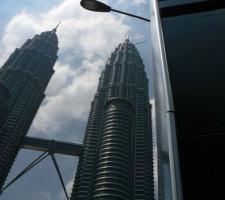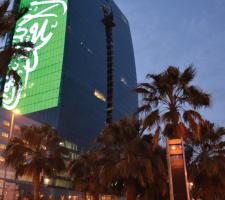
Traditional, fixed, pole-mounted cameras such as that pictured are being allied to mobile and average speed solutions in comprehensive enforcement regimes
Jenoptik Robot’s Ralf Schmitz talks about enforcement deployments in developing countries, and how those with long-established histories still have much to learn
In the enforcement sector, the concept of technology provider also being responsible for operations is hardly a new one. Nevertheless, it has gained significant traction over the last five or six years and has the potential to radically change the complexion of the industry according to“Looking worldwide, the trend started in about 2000, with smaller-scale projects here and there. Project sizes quickly grew, with the effect that projects’ decision times became longer and longer. We’ve reached a point where gestation periods can be as long as six to seven years,” he says.
“The trend has hardened since around 2005/6 with the result that we now see perhaps one to two projects a year – customers tend to be countries so inevitably they’re limited in number and a national-level presence is needed in order to meet KPIs.
“For companies like us, that means a move away from being a traditional hardware supplier. Clients want added value – services and expertise. Most of all, they want expert knowledge from abroad, although local agents tend to sit in front of the local ministries.”
Prime markets
“The bigger projects are usually generated in countries where very little has happened in the past. This is related to political strategies – pressures to reduce accidents and so on. You need governments with an understanding of the issues and the budgets to effect change.“Western Europe has been a mature market for many decades now. We still see some growth and some equipment upgrades but very few projects which are national or even regional in scale. That’s because there tends not to be centralised decision-making; instead we see community-level decisions on strategies and orders.
“Eastern Europe, Middle East and Asia is more characterised by centralised decision-making and there are the budgets for major projects. Countries there tend to have no history of automated enforcement but want quick solutions and with no strong local manufacturing industry they have to look abroad.
“In Northern Africa, we’re seeing much the same things happening, perhaps driven by the proximity of the countries there to the Mediterranean Sea and so to countries such as Spain and Italy where they can see what’s being done abroad; countries such as Algeria, Morocco, Tunisia and Egypt all want to emulate what’s going on in Europe and seem to be finding the budgets for implementation. Central African countries are doing very little as yet, whereas South Africa is already a mature market.
“There are countries in Asia and South America where traffic safety isn’t an issue at present but will be soon.”
Holistic approach
In terms of technological enablers clients want a full turnkey project, Schmitz says: “They want the road technology, communications and processing software, as well as an understanding of the whole process.“That requires local recruitment and training – you have to enable the client to operate a national system. The concept has to make sense in terms of ease of use and total cost of ownership over a period of years.
“Many things affect customer awareness, because automated enforcement isn’t just about setting up cameras and taking pictures. Processing capabilities are also needed – clients need to know how to contact offenders and enforce fines. It’s better that they wait a year or two with a country-sized project to make sure they’re on solid ground. That includes getting the right legislation in place before go-live – that in itself has caused a year or two of delay in some cases.
“We recommend to clients that they prepare properly first and then embark on projects, or else start with a small project; ‘small’ in this case might be a city or town rather than a whole region or country. Even a 10-camera proof-of-concept can be a challenge where nothing has been done before but it allows you to hand over a concept – get the telecommunications right and raise public awareness.”
Technology mix
Most countries, he continues, want a mix of enforcement strategies.“So, for speed measurement, we’re talking about traditional, fixed, polemounted cameras but also mobile and average speed solutions. A proper mix makes sense to most clients. Again, that’s a product of awareness of both the advantages and disadvantages of the various technologies as well as the upfront costs of a major deployment.
“Modern, digital cameras with communications and onboard software capabilities can also provide information on driving patterns but with many clients it’s a case of slowly learning where to place enforcement technology. Strategic policy considerations are coming to the fore more and more and I’ve even seen cases where the winning bidder for a contract was asked to commit to year-onyear accident reductions. It’s unusual to ask a systems supplier to commit tosomething like that but it makes sense.
“I can also see being asked to address the reductions issue becoming a growing trend. It means getting involved in even closer relationships, sitting right alongside the client to ascertain and then achieve their goals. The technology to do all this is mature but will continue to develop but technology will no longer be the deciding factor; partnership working will be the key.
Type approval
“The trend in the equipment itself is towards non-invasive technology. In-road systems will slowly disappear, I think. Of course we have to differentiate as some countries have a very strong type approval culture. Where very conservative attitudes prevail, this is sometimes a block to innovation.“Type approval is important but if international suppliers avoid a market because of it then that’s not a good thing. We perhaps need a middle course.”
Learn and relearn
What this results in is a level of technology being deployed in developing countries which compares very favourably with – and often even betters – that fielded in the European market, which has long been regarded as the world’s most mature.“Developing countries allow innovation,” says Schmitz. “Yes, they want accurate, reliable systems which meet, for example, European standards but they take a more pragmatic approach and are happy to give technology a chance.
“The developed countries are far ahead in terms of user experience. It’s not uncommon to see three or four generations of systems co-existing – because the roads and infrastructure are already there. Developing countries, by comparison, can decide on the most appropriate enforcement strategy as a road is being built. They can set up everything new, taking advantage of the latest and fastest communications principles, or the best way to supply power. They can actively and more closely integrate enforcement into traffic management regimes, rather than have it continue to exist as a discrete entity.
“We’ve reached a point where the developed countries can actually learn a lot from the late-starters.”














